A knee brace is a medical device you can use to reduce knee pain from arthritis, meniscus injuries, and other musculoskeletal problems that affect your knee.
Older adults often find knee braces good to have on hand, both for sports-related injuries and for chronic degenerative conditions like osteoarthritis.
A properly-constructed knee brace can help reduce pain and increase quality of life, but selecting the right kind of knee brace to fit your needs is important.
The following represent the top knee braces for 2023 as determined by our experts.
Rankings
1. Athledict Knee Brace and Compression Sleeve
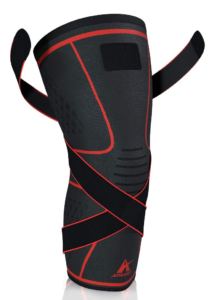
Click here for the lowest price on Amazon
The Athledict Knee Brace and Compression Sleeve manages to combine the best elements of a knee sleeve and a knee brace, offering compression, proprioceptive feedback, and solid mechanical support to the knee.
It’s great both for people who are active and for people who just want to lessen their knee pain from arthritis.
Why we like it: Often, you have to choose between compression-style knee sleeves, which can help with swelling, pain, and instability, and strap-style knee braces, which offer more direct offloading of the knee joint to reduce mechanical loads.
Athledict helps you avoid having to choose between these options: this knee brace gives a very nice level of compression and proprioceptive feedback from the long, tight sleeve, but also the ability to mechanically offload your knee joint with the strong straps.
Flaws: The only potential flaw in this product is the lack of side supports: if you need heavily-restricted knee motion outside your knee’s normal plane of motion, it may be better to opt for a knee brace with explicitly designed hinges or side springs, either removable or not.
2. Bracoo Knee Support
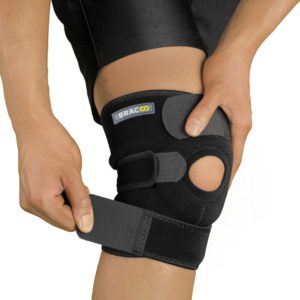
Click here for the lowest price on Amazon
Bracoo strikes a nice balance between stability and mobility with their adjustable knee brace. It sports a horizontal strap above and below the knee, as well as an added stability strap on the outside of the knee to adjust the lateral support.
Why we like it: Bracoo offers adjustable lateral stability, which can help adjust exactly how forces are distributed inside your knee joint. This might make it a good fit for people with either medial or lateral arthritis in their knee who want to shift around where forces are going in their joint.
Flaws: The Bracoo Knee Support doesn’t offer quite the same compression as some of its other competitors, and for serious knee pain, it lacks cross-strapping or rigid side supports.
3. UFlex Athletics Knee Sleeve
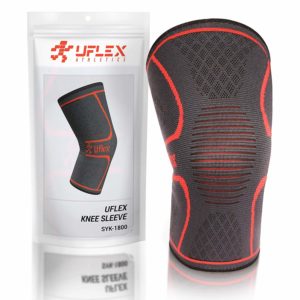
Click here for the lowest price on Amazon
The UFlex Athletics Knee Sleeve is perhaps the best sleeve-style knee brace on the market. It provides mild compression and stabilization to improve your knee control and increase your joint stability.
Why we like it: The seamless construction and wide range of sizes available mean that even people with very large or very small legs will be able to get the right level of support. The large height of the knee brace also means you’ll get maximum proprioceptive feedback from the brace, which will help you be more stable and confident during exercise.
Flaws: Since this is really just a well-made knee sleeve, you aren’t getting solid mechanical support, which means this knee brace can’t protect you from abnormal range of motion or create any offloading to improve arthritis.
4. Shock Doctor Hinged Knee Brace
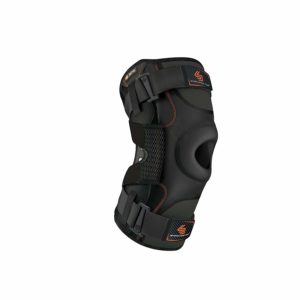
Click here for the lowest price on Amazon
If you’ve hurt a ligament in your knee, or injured your meniscus, you likely need a heavy duty and supportive knee brace. Shock Doctor is top-notch on this front: It provides strong bracing and rigid lateral supports that prevent your knee from moving outside a prescribed plane of motion.
Why we like it: Strong support and powerful offloading is the name of the game with this knee brace. Its large height also helps it spread out forces across a greater area on your upper and lower legs.
Soft knee braces can’t prevent your knee from rotating out of its normal plane of motion, but the Shock Doctor HInged Knee Brace certainly can.
Flaws: The support in this knee brace is so strong that you might find it a bit tight when you start wearing it.
Users report that it can take a few days for it to break in, and it’s important to measure your leg carefully to make sure you get the right size. Lastly, this knee brace is so supportive that it might be overkill for some people.
5. 3M Futuro Knee Brace
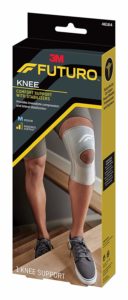
Click here for the lowest price on Amazon
The 3M Futuro Knee Brace is a soft knee brace made from a synthetic fiber that provides mild compression, stability, and proprioceptive feedback. It’s a knee sleeve style brace, so it is well-suited for sports and other types of exercise.
Why we like it: If you have a minor knee injury, a bit of knee swelling, or a slightly unstable knee, the Futuro Knee Brace is a good way to keep your knee feeling stable without sacrificing much in the way of range of motion. It’s low profile and does not have seams that will irritate your skin.
Flaws: Like other knee sleeves, you aren’t getting much in the way of actual mechanical offloading from this knee brace. This knee brace is also somewhat limited in its sizing: people with very large legs may struggle to find a size that accommodates their knees without compressing too hard. People with more serious knee problems, like arthritis, may need a sturdier knee brace.
6. Bodyprox Knee Brace
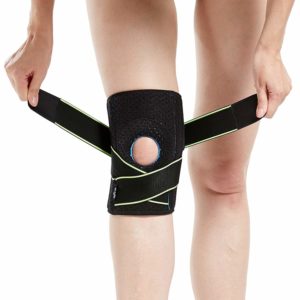
Click here for the lowest price on Amazon
The Bodyprox Knee Brace is a pretty standard knee brace that offers some stability to your patella, and has removable side supports that can limit out-of-plane motion at your knee.
The straps provide a moderate amount of stability, making this a good middle of the road pick.
Why we like it: The Bodyprox Knee Brace offers some mechanical support without being overly restrictive or heavy-duty. You can still wear it under pants as long as they aren’t skin-tight, and the velcro straps allow for easily adjustable support levels.
Flaws: While the Bodyprox Knee Brace accommodates a range of leg sizes, if your legs are particularly big or particularly small, you may have a hard time getting any benefit from this knee brace.
Further, it’s not the heaviest-duty strap out there, so it may not be the best for more painful cases of arthritis. Finally, it is shorter (in terms of height) than some other options, which may hurt its force offloading ability.
7. Neo G Knee Brace
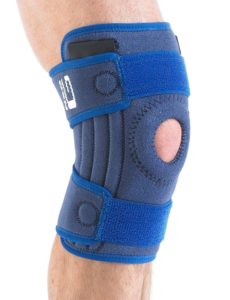
Click here for the lowest price on Amazon
The Neo G Knee Brace is a middle of the road option if you mostly need patella support and aren’t relying on your knee brace for much in the way of compression. It has a special strap for providing lateral reinforcement, but only on the inside of your knee.
Why we like it: The Neo G Knee Brace is rare among simpler low-profile knee braces in that it allows for adjustable support on the inside of the knee via an adjustable velcro strap.
You can restrict internal motion of your knee with this strap, which may allow you to adjust how forces are distributed inside your knee (making it useful for arthritis of the knee).
Flaws: Without more advanced cross-strapping, it’s hard to truly customize the support given by this knee brace. It also does not come with side support, and the outside of the knee is not as reinforced as the inside, so it may not be the best choice if you have a serious knee injury or a lot of knee pain.
8. Sportout Knee Brace
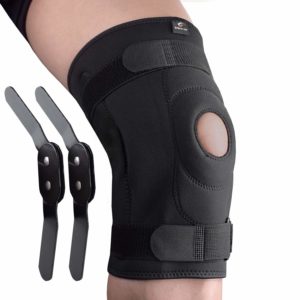
Click here for the lowest price on Amazon
The Sportout Knee Brace uses rigid, removable aluminum hinges to reinforce the knee in the lateral directions, only permitting knee motion in one direction. It’s a solid option if all you need is hinge-type support, but don’t need very strong reinforcement or offloading at the knee joint itself.
Why we like it: This knee brace is a simple solution for restricting off-plane knee motion, and since the hingest are removable, you can “graduate” to less support once you are ready in your rehabilitation process.
Flaws: Since the strapping isn’t as heavy-duty as some other options on the market, you don’t get the same degree of off-loading of forces. And, since the brace itself doesn’t use compressive fabrics, it doesn’t provide as much in the way of compression. For this reason, this knee brace is less well-suited for arthritis, chronic knee injuries, or swelling.
9. KARM Adjustable Knee Brace
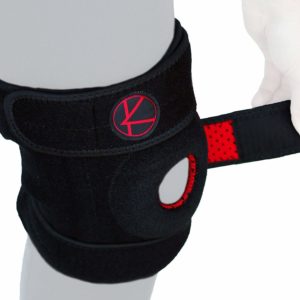
Click here for the lowest price on Amazon
KARM’s Adjustable Knee Brace has a pretty simple, breathable, and easily adjusted design. Its kneecap cutout makes it well-suited for providing support and tracking for patella-related knee injuries.
Why we like it: If you want a simple and no-fuss knee brace that you can slip on, tighten up, and be on your way, KARM is a good way to go. It doesn’t have the advanced features of some other products, but some people don’t need a complicated criss-crossing strap system or compression sleeves.
Flaws: The height of the KARM Adjustable Knee Brace is relatively small, which means that this knee brace has a smaller area to spread out load. That means it’s not likely to be as successful for people with arthritis or meniscus injuries, who could benefit from offloading the knee joint.
Since the straps wrap horizontally around the knee, they don’t actually contribute much to mechanical support and stability across the knee, especially outside the knee’s normal range of motion. Products with a more advanced design are likely to be more versatile and helpful.
10. Cho-Pat Dual Action Knee Strap
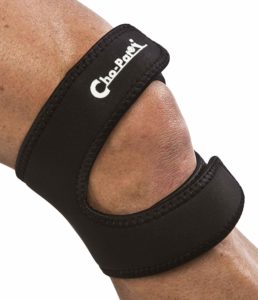
Click here for the lowest price on Amazon
The “Pat Strap” was originally designed for runners having knee problems, but it’s become widely popular for people who have knee trouble during activities. It’s far smaller and less limiting than other knee braces, which has advantages and disadvantages.
Why we like it: If you have patellar tendon problems, kneecap problems, or knee tracking issues, the Cho-Pat Dual Action Strap is a good way to stay active while reducing your knee pain.
Many people find the Pat-Strap helps them run pain-free. It’s far less restrictive than other knee braces on the market, so if you don’t need heavy duty support, it might be worth a shot.
Flaws: Since the Cho-Pat Dual Action Knee Strap is so small, it can only offer direct compression and support of the kneecap and the patellar tendon. It won’t be able to offload the knee joint to any significant extent, so it’s not likely to help with arthritis.
Finally, for most people with mild to moderate knee pain during activity, a knee sleeve is a better and less restrictive choice for a knee brace, so the Pat-Strap fills only a small niche role in the market.
Who Should Buy Knee Braces?
If you have sustained a knee injury recently, or if you have a history of recurrent knee pain, a knee brace may help you get back to your usual daily activities faster and with less pain.
Knee braces are perhaps best known for their role in treating sports injuries like minor meniscus tears, or as rehabilitation tools for people who have undergone a surgical procedure for meniscus or ligament injuries in the knee.
However, knee braces can also help people who have arthritis in their knee (one of the most common locations for osteoarthritis). Knee braces help either offload forces from the knee entirely or shift its distribution away from areas where your cartilage is damaged.
People who have mild or moderate chronic knee stiffness, swelling, or pain also find knee braces quite useful; often, they don’t need as much support and structure in their knee brace as people trying to offload their knee to allow an injury to heal or to alleviate the pain associated with arthritis.
Finally, some knee braces aren’t much more than a sleeve that goes over your knee. These “knee sleeves” serve a niche purpose: though they can’t provide much in the way of mechanical support, they increase proprioceptive feedback around your knee, which gives you more stability and confidence.
How We Ranked
We based our rankings of the top knee braces on the market on their ability to provide one or more kinds of assistance to knee function.
Broadly speaking, there are three ways in which a knee brace can help with knee pain: It can directly offload force from the knee; it can alter the distribution of forces, either by guiding the knee through a pre-specified range of motion or by altering skeletal alignment; or it can improve proprioceptive feedback without restricting range of motion.
Our team categorized knee braces as belonging primarily to one of these main categories, then rated them on their ability to provide the intended form of support, as well as their comfort, ease of use, and durability.
Offloading knee cartilage is the most difficult task a knee brace can aspire to do, so relatively few of these products made the grade. Forces need to be transferred from the lower leg to the upper leg, bypassing the knee joint itself. That’s why these braces tend to require heavy construction and fairly stiff strapping. As a result these braces scored worse on comfort ratings as well.
This is tricky to do right, but since these kinds of braces act more like guides and less like a crutch, they can be somewhat softer and still achieve their stated goal.
As a result, these braces scored higher in comfort ratings. More braces in this category got eliminated for poor durability, though—if a knee brace is too soft, it will fall apart relatively quickly, and won’t provide the level of biomechanical support that’s needed.
Finally, for knee braces designed primarily for proprioceptive feedback or compression, comfort and construction was of primary importance. We specifically checked to see if inner seams in the fabric were constructed so they would not irritate skin and that the level of compression was not too aggressive.
FAQs
Q: Are knee braces good for running?
Runners may benefit from either a light compression knee sleeve, or a very lightweight patellar strap that provides some mild support and proprioceptive feedback. Anything more sturdy than this is probably going to hinder running more than helping it.
Q: Do knee braces help with arthritis?
A: There is lots of evidence that using knee braces can help with arthritis (1); if you find the right kind of knee brace, you can offload some of the force in your knee joint by increasing the “open” space inside the joint capsule. While these effects can lead to symptom improvement, they don’t seem to be as effective for poeple who are overweight or obese.
Q: Can you wear a knee brace all the time?
For temporary injuries, a knee brace is meant to protect the knee while your injury heals. As you improve, you should work your way towards using the brace less and less. For chronic conditions like arthritis, you may indeed want to wear a knee brace all the time.
Q: Can you wear a knee brace over jeans?
A: Yes, you can wear more rigid styles of knee brace over jeans or other pants, but you should be aware that some styles of knee brace may not function as intended. Knee braces with straps need to be adjusted carefully to avoid pushing fabric creases into your leg, and the support structures (especially for the kneecap) may not work as intended. A hinged knee brace should work just fine over jeans, though.
Q: Can you sleep in a knee brace?
A: It’s probably better not to sleep in a knee brace, unless your doctor is having you use one to avoid putting your knee in certain positions.
Q: What are hinged knee braces for?
A: A hinged knee brace is meant for restricting the motion of your knee to a prescribed range. A hinge ensures that your knee joint does not move at all “off-plane,” which is very helpful when recovering from a ligament or meniscus injury. Often, these injuries occur when the knee is bent at an abnormal angle. Hinged knee braces explicitly avoid this by locking the motion of the knee.
Q: Is a patellar strap good for knee pain?
A: A patellar strap is a minimalist knee brace that is designed to apply pressure to your patellar tendon (2). They’re quite popular among runners, but even if they do work as intended, they won’t be able to offload any forces from the knee, or prevent abnormal knee angles.
Q: How tight should a knee brace be?
A: A knee brace should be “snug but not too tight”—snugness is necessary to ensure that you are getting the intended level of support. However, a knee brace that is too tight will cut off circulation and can inhibit muscle function, which is definitely not what you want (3).
Recap
Knee braces come in a range of styles, from simple compressive sleeves to middle of the road strap-based systems to heavy-duty hinged braces that provide only a prescribed range of motion.
For people with injuries, knee braces help protect the injured area while it heals. For people with chronic injuries, stiffness, or swelling, a knee brace can provide stability and support to prevent further damage.
And for people with arthritis, a knee brace may be able to offload force by increasing the spacing of the bones in your knee joint.
For cpoe.org’s #1 knee brace recommendation, click here.

